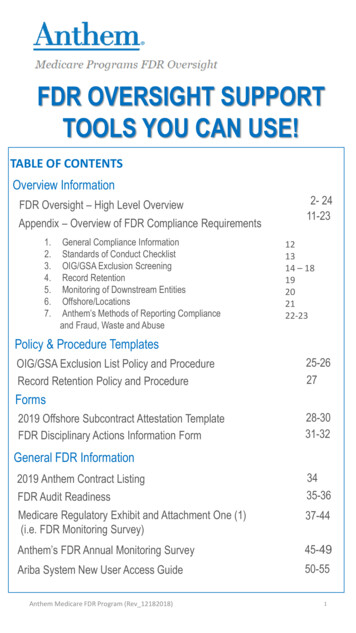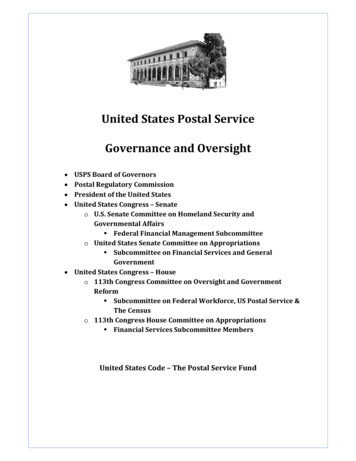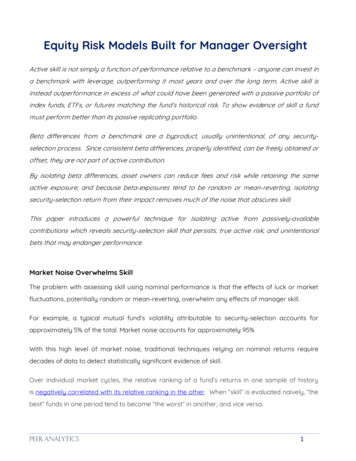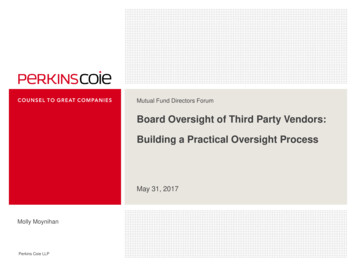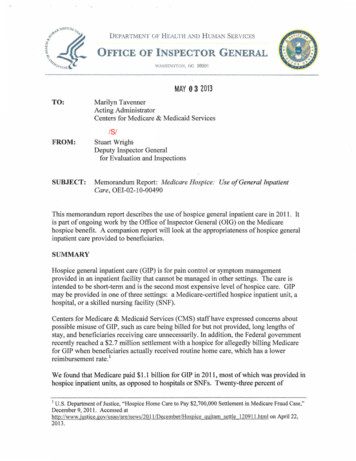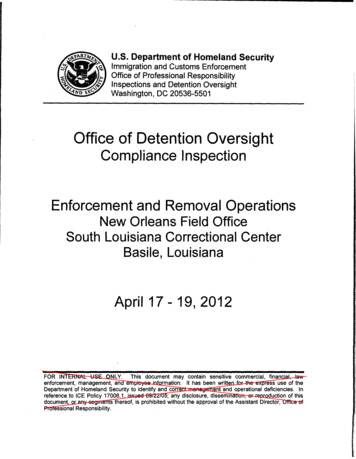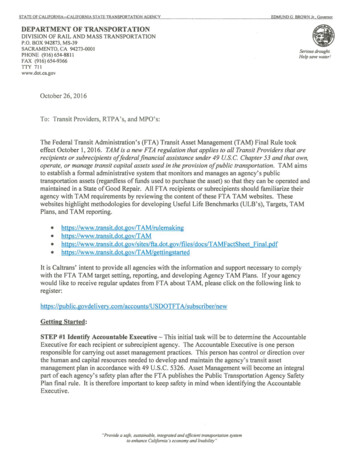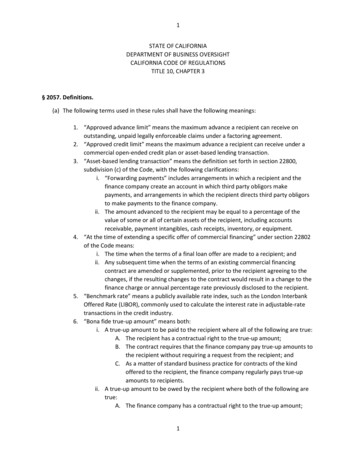
Transcription
1STATE OF CALIFORNIADEPARTMENT OF BUSINESS OVERSIGHTCALIFORNIA CODE OF REGULATIONSTITLE 10, CHAPTER 3§ 2057. Definitions.(a) The following terms used in these rules shall have the following meanings:1. “Approved advance limit” means the maximum advance a recipient can receive onoutstanding, unpaid legally enforceable claims under a factoring agreement.2. “Approved credit limit” means the maximum advance a recipient can receive under acommercial open-ended credit plan or asset-based lending transaction.3. “Asset-based lending transaction” means the definition set forth in section 22800,subdivision (c) of the Code, with the following clarifications:i. “Forwarding payments” includes arrangements in which a recipient and thefinance company create an account in which third party obligors makepayments, and arrangements in which the recipient directs third party obligorsto make payments to the finance company.ii. The amount advanced to the recipient may be equal to a percentage of thevalue of some or all of certain assets of the recipient, including accountsreceivable, payment intangibles, cash receipts, inventory, or equipment.4. “At the time of extending a specific offer of commercial financing” under section 22802of the Code means:i. The time when the terms of a final loan offer are made to a recipient; andii. Any subsequent time when the terms of an existing commercial financingcontract are amended or supplemented, prior to the recipient agreeing to thechanges, if the resulting changes to the contract would result in a change to thefinance charge or annual percentage rate previously disclosed to the recipient.5. “Benchmark rate” means a publicly available rate index, such as the London InterbankOffered Rate (LIBOR), commonly used to calculate the interest rate in adjustable-ratetransactions in the credit industry.6. “Bona fide true-up amount” means both:i. A true-up amount to be paid to the recipient where all of the following are true:A. The recipient has a contractual right to the true-up amount;B. The contract requires that the finance company pay true-up amounts tothe recipient without requiring a request from the recipient; andC. As a matter of standard business practice for contracts of the kindoffered to the recipient, the finance company regularly pays true-upamounts to recipients.ii. A true-up amount to be owed by the recipient where both of the following aretrue:A. The finance company has a contractual right to the true-up amount;1
27.8.9.10.11.12.13.14.15.16.17.18.B. As a matter of standard business practice for contracts of the kindoffered by the recipient, the finance company regularly charges true-upamounts to recipients.“Code” means the California Financial Code.“Closed-end transaction” means a transaction in which credit is extended only once overa specific period and is repaid in regular predetermined payments of a specified amountover a fixed period of time.“Depository institution” means any of the entities defined under section 22800,subdivision (h) of the Code and does not include any non-depository subsidiaries oraffiliates of such entities.“Finance charge” means the amount of any and all costs of credit, represented as adollar amount, as more specifically described in section 3010 of these rules.“Finance company” means the individual or institution providing the commercialfinancing to the recipient.“Initial interest rate” means, in a credit transaction with an interest rate that changesover time, the rate that would be in effect at the time a disclosure is made, assumingthe recipient accepted the financing offer.“Interest Rate” means the periodic rate at which interest accrues on the outstandingprincipal balance for a closed-end transaction, commercial open-end credit plan, orasset-based lending transaction.“Margin” means, in a credit transaction with an adjustable interest rate, the standardadjustment to the benchmark rate designated in the contract used to calculate theperiodic interest rate.“Maximum non-interest finance charge” means:i. For all commercial financing except factoring, the maximum amount of thefinance charge other than interest accrued since the last payment that arecipient may be required to pay if the recipient chooses to prepay theoutstanding balance due under a commercial financing agreement.ii. For factoring, the maximum amount of the finance charge other than interestaccrued since the time of the financing company purchased the legallyenforceable claim, that the recipient may be required to pay if the recipientrepurchases the account receivable before the account receivable is due forpayment by the account debtor.“Particular payment channel or mechanism” means, with respect to sale-basedfinancing, the payment channel(s) or mechanism(s) designated in the contract betweena recipient and the finance company that will be used to determine the amount of arecipient’s payment or a true-up amount.“Person” means any of the entities defined under section 22800, subsection (l) of theCode, except that this chapter shall only apply to the entities defined if they aredomiciled, headquartered, or otherwise identify their principal place of business inCalifornia and are the entity seeking the commercial financing (i.e., not a third-partybroker).“Provider” means the definition set forth in section 22800, subsection (m) of the Code.Within that definition, the phrase “administered by” excludes an arrangement whereby2
319.20.21.22.23.24.25.26.a non-depository institution provides technology or support services for a depositoryinstitution’s branded commercial financing program so long as the non-depositoryinstitution has no interest, or arrangement or agreement to purchase any interest in thecommercial financing extended by the depository institution in connection with suchprogram.“Retrospective annualized rate” is the actual annualized rate, determined after thespecific financing contract has been fully repaid to the finance company, when the datesand amounts of payments and fees are known.“Sales-based financing” means a transaction that is repaid by a recipient to the financecompany as a percentage of sales or income, in which the payment amount increasesand decreases according to the volume of sales made or income received by therecipient. Sales-based financing also includes transactions with a “true-up mechanism.”“Specified payment amount” means the periodic pre-set amount stated in the contractdescribed in subdivision (a)(24)(i) of this section.“Split rate” means, with respect to sales-based financing, the percentage number usedby the finance company to calculate the payment amounts paid to the finance companyor the true-up amount.“Term” means, with respect to all commercial financing except factoring, the length oftime that it is anticipated will be necessary for the recipient to fulfill its obligationsunder a financing agreement.“True-up mechanism” means, with respect to sales-based financing, a contractualarrangement with all of the following elements:i. The finance company receives periodic payments based upon a pre-set amountstated in the contract;ii. The contract specifies that, over the term of the contract, the finance companywill receive amounts based upon a percentage of the recipient’s sales orincome.iii. The finance company periodically reviews the sales or income received by therecipient to determine whether the amounts received by the finance companyduring the previous period are greater than or less than the percentagedescribed in subdivision (a)(19) of this section.iv. The finance company pays or charges the recipient an amount necessary tomake average amounts collected by the finance company during the previousperiod equal to the percentage described in subdivision (a)(24)(ii) of thissection.“True-up period” means a period reviewed by the finance company to determinewhether the amount collected is greater than or less then the percentage described insubdivision (a)(24)(ii) of this section.With respect to factoring transactions:i. “Account debtor” means the debtor with the primary obligation to pay thelegally enforceable claim assigned by the recipient.ii. “Factoring fee” means the face value of a legally enforceable claim minus theoriginal advance amount and the reserve amount, if applicable.3
4iii. “Maximum receivable term,” under a general factoring agreement of the kinddescribed by section 22803 of the Code, means the maximum length of timebetween when a finance company will accept a legally enforceable claim andwhen that legally enforceable claim will become due and payable by the legallyenforceable claim’s account debtor.iv. “Original advance amount” means the amount that a finance company issues toa recipient upon receipt of a legally enforceable claim for payment before thefinance company receives full payment of the legally enforceable claim.v. “Reserve amount” means, in a reserve factoring transaction, the amount that isequal to the face value of the legally enforceable claim minus the originaladvance amount and fee retained by the finance company, that is paid to therecipient on or after the date that the finance company receives full paymentfor the legally enforceable claim.vi. “Reserve factoring transaction” means a factoring transaction, where uponreceipt of a legally enforceable claim for payment, a finance company advancesan original advance amount to the recipient that is less than the face value ofthe legally enforceable claim minus the factoring fee, and where, upon timelypayment in full of the legally enforceable claim, the finance company pays therecipient an amount equal to the face value of the legally enforceable claimminus the original advance amount and the factoring fee.(b) All terms used in these rules which are defined in Division 9.5, section 22800 of the Code but notdefined in these rules, shall have the meanings ascribed to them in Division 9.5, section 22800 ofthe Code.§ 2060. General Formatting and Content Requirements.Disclosures provided in accordance with sections 22800 through 22804 of the Code shall comply withthe following requirements:(a) At the top of the disclosure, centered on the page or other display medium, the provider shallprint the following statement in bold font: “This disclosure is provided in accordance withCalifornia law to help you understand the cost of your small business financing.”(b) At the bottom of the disclosure, below any other information required by this Article, theprovider shall print the following statement: “By signing below, you are confirming that youreceived this form.” Below the statement, the provider shall include a space for the applicant tosign the form labeled “Applicant Signature” and a space for the applicant to write the date oftheir signature labeled “Date.”(c) The term or estimated term of a transaction shall be disclosed in units of years and months, withany remaining days expressed as a portion of a month to the nearest two decimal points. Forthe purposes of these disclosures, a provider may assume that there are 30 days in every monthand 360 days in a year. For example, a term of 400 days would be disclosed as “1 year, 1.33months”.(d) The annual percentage rate shall be expressed to the nearest ten basis points.(e) The provider shall use the following font sizes for disclosures:4
51. For the third column of a disclosure table, ten-point font.2. Where the second and third columns are combined, ten-point font for the resultingcolumn.3. Where the second and third columns of a disclosure table are not combined, bold,sixteen-point font for the second column.4. Notwithstanding subdivisions (e)(1) and (e)(2) above, in any row where the first columnincludes the language “Prepayment”, twelve-point font for any columns in the same row.5. In all other cases, twelve-point font.(f) The disclosures shall be presented to the recipient as a separate document from any othercontract or disclosure document provided to the recipient.§ 2061 Closed-End Transaction Formatting and Content Requirements.Disclosures for closed-end transactions provided in accordance with section 22802 of the Code shallcomply with the following requirements, unless the closed-end transaction meets the definition of salesbased financing:(a) The provider shall present the disclosures in a table consisting of seven rows and three columns.(b) The first row of the table shall include only the following information:1. In the first column, the following language: “Amount of Funds Provided.”2. In the second column, the amount of funds that will be provided to the recipient,excluding any deductions.3. In the third column, a description of how the amount in the second column wascalculated. For example: “This is your loan amount of [loan amount] minus the [amountand description of fees deducted].”(c) The second row of the table shall include only the following information:1. In first column:a. If the contract provides for a fixed interest rate or rates that are predeterminedby the contract, or no interest rate, the following language: “Annual PercentageRate (APR)”.b. If the contract provides for an adjustable interest rate calculated using abenchmark rate and a margin, the following language: “Estimated AnnualPercentage Rate (APR)”.2. In second column, the annual percentage rate calculated in accordance with section3001 of these rules.3. In the third column:a. The following language, if the contract provides for a single, fixed interest rate:“This is the cost of your financing – including interest and other fees – expressedas a yearly rate. APR incorporates the amount and timing of the funding youreceive, fees you pay, and the periodic payments you make.APR may be used to compare products with different interest rates and financecharges. Your APR is not an interest rate. Your interest rate is [interest rate].5
6Your APR may be higher than your interest rate because APR incorporatesinterest costs and other finance charges.”b. The following language, if the contract provides for a multiple pre-determinedinterest rates that change over time:“This is the cost of your financing – including interest and other fees – expressedas a yearly rate. APR incorporates the amount and timing of the funding youreceive, fees you pay, and the periodic payments you make.APR may be used to compare products with different interest rates and financecharges. Your APR is not an interest rate. Your initial interest rate is [interestrate]. Your APR may be higher than your interest rate because APR incorporatesinterest costs and other finance charges.”c. The following language, if the contract provides for an adjustable interest ratebased upon a benchmark rate and a margin:“This is the cost of your financing – including interest and other fees – expressedas a yearly rate. APR incorporates the amount and timing of the funding youreceive, fees you pay, and the periodic payments you make.APR may be used to compare products with different interest rates and financecharges. Your APR is not an interest rate. Your initial interest rate is [initialinterest rate]. Although your interest rate will adjust over time based upon the[name of benchmark rate], for the purposes of this APR estimate, we haveassumed that APR will be fixed for the length of the transaction. Your APR maybe higher than your interest rate because APR incorporates interest costs andother finance charges.”d. The following language, if no part of the finance charge is based upon interestaccrued:“This is the cost of your financing expressed as a yearly rate. APR incorporatesthe amount and timing of the funding you receive, fees you pay, and theperiodic payments you make.APR may be used to compare products with different interest rates (or nointerest rate) and finance charges. Your APR is not an interest rate, and yourloan does not have an interest rate.”(d) The third row of the table shall include only the following information:1. In first column:6
7a. If the contract provides for a fixed interest rate or rates that are predeterminedby the contract, or no part of the finance charge is based upon interest accrued,the following language: “Finance Charge”.b. If the contract provides for an adjustable interest rate calculated using abenchmark rate and a margin, the following language: “Estimated FinanceCharge”.2. In second column, the total finance charge, calculated in accordance with section 3010of these rules.3. In the third column:a. The provider’s calculation of the finance charge, with the amount anddescription of each expense (e.g. interest, origination fee, etc.) included in thefinance charge.b. If the contract provides for an adjustable interest rate calculated using abenchmark rate and a margin, an explanation of how the initial interest rate wasused to calculate interest charges. For example:This finance charge estimate assumes the interest rate will be [initial interestrate], which is the initial interest rate that would be in effect today under yourcontract. Your interest rate will adjust over time based upon the [name ofbenchmark], so your actual finance charge will vary.(e) The fourth row of the table shall include only the following information:1. In the first columna. If the periodic payments will not vary over the term of the transaction or theperiodic payments during the term of the transaction will vary and it is possibleto calculate the payment amounts in advance, the following language:“Payment Amount/Frequency”.b. If the periodic payment amounts will vary over the term of the transaction andit is not possible to calculate the payment amounts in advance (e.g. due to anadjustable interest rate using a benchmark rate and a margin), the followinglanguage: “Initial Payment Amount/Frequency”.2. If periodic payments during the term of the transaction will not vary:i.In second column, the amount of each periodic payment followed by a forwardslash (/) and the frequency of each periodic payment (month, day, etc.).ii.In the third column, a short explanation of the payment frequency. Forexample: “This is how much you will pay [frequency of payments, ex. eachmonth].” The provider may also include a short statement describing when eachpayment will become due. For example: “Your monthly payments are due onthe 1st of every month.”)3. If periodic payments during the term of the transaction vary and it is possible tocalculate the payment amounts in advance, the second and third column in the fourthrow shall be combined and the provider shall list the periodic payment amounts with adescription of when each amount will become due. For example:7
8Months 1-12: 600/monthMonths 13-24: 1200/monthOrPayments 1-23: 600/monthPayment 24: 2000.4. If periodic payments during the term of the transaction vary and it is not possible tocalculate all payment amounts in advance because the transaction has an adjustableinterest rate based upon a benchmark rate and a margin:a. In the second column, a payment amount calculated using the initial interestrate.b. In the third column, a statement explaining that the payment amount disclosedis based upon the initial interest rate, and that the actual rate may change overtime. For example: “This initial payment amount is based upon the interest ratethat would be in effect today for your adjustable rate financing. This rate willadjust over time so your actual payment amount may vary.” The provider mayalso include a statement describing when the payment will adjust and how itwill be calculated. For example: “Your payment will adjust monthly based uponLIBOR.”(f) The fifth row of the table shall include only the following information:1. In first column, the following language: “Term”.2. In second column, the term of the transaction.3. In third column, an explanation describing the term. For example: “This is how long youwill make payments under the contract.”(g) In the first column, the sixth and seventh rows shall be combined and shall include only thefol
outstanding, unpaid legally enforceable claims under a factoring agreement. 2. “Approved credit limit” means the maximum advance a recipient can receive under a commercial open -ended credit plan or asset-based lending transaction. 3. “As
